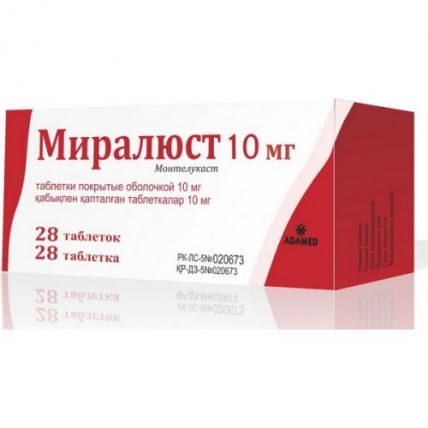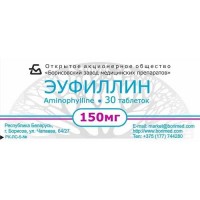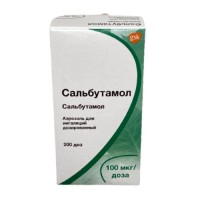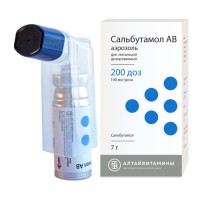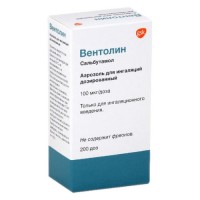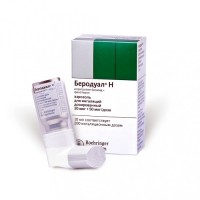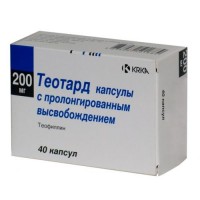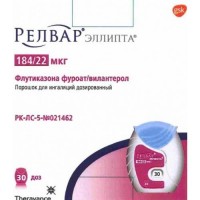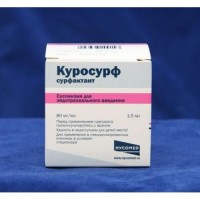Miralyust 28's 10 mg coated tablets
- $52.00
Out Of Stock
The instruction for medical use of Miralyust Torgovoye medicine a name of Miralyust the International unlicensed name Montelukast Dosage Form of the Tablet, coated, 10 mg Structure One tablet contains active agent: montelukast of sodium of 10.38 mg (it is equivalent to montelukast of 10 mg) excipients: cellulose microcrystalline (type 101), lactoses monohydrate (type of 200 M), sodium of a kroskaramelloz, hydroxypropyl cellulose (Klucel LF), magnesium stearate, Opadri's cover 20A27025 Pink. Structure of a cover: hydroxypropyl cellulose, hydroksipropilmetiltsellyuloza 6sr, titan dioxide (E 171), gland (III) oxide yellow (E 172), gland (III) oxide red (E 172), gland (III) oxide black (E 172). The description of the Tablet of round shape, with a biconvex surface, coated beige color, with an engraving '10' on one party, with a diameter of 8 mm. Pharmacotherapeutic group Drugs for treatment of obstructive respiratory diseases. Other drugs for treatment of obstructive respiratory diseases for system use. Leukotriene receptors antagonists. Montelukast. ATX R03DC03 code Pharmacological Pharmacokinetics Absorption properties. Montelukast after intake is soaked up quickly. At adults after intake on an empty stomach of drug average maximum concentration in plasma (Cmax) is reached after 3 hours (Tmax). The average bioavailability after oral administration is 64%. Standard meal does not affect bioavailability and Cmax after oral administration of drug. Distribution. Montelukast contacts proteins of plasma more than for 99%. Metabolism. Montelukast is exposed to intensive metabolic changes. Metabolites do not render therapeutic effect. Discharge. The clearance of montelukast averages at healthy adult 45 ml/min. After oral administration of montelukast, 86% of its quantity are removed with a stake within 5 days and less than 0.2% – with urine that confirms that montelukast and its metabolites are excreted almost only with bile. Elimination half-life of montelukast at young healthy adults makes from 2.7 to 5.5 hours. The pharmacokinetics of montelukast keeps almost linear character at intake of doses over 50 mg. At intake of montelukast in morning and evening hours of distinctions of pharmacokinetics it is not observed. At reception of 1 times in day of tablets of coated 10 mg the cumulation of active agent in plasma is observed moderated (about 14%). A pharmacodynamics Cysteic leukotrienes (LTC4, LTD4, LTE4) are eicosanoids with considerable inflammatory effect, are released from various cells, including mast cells and eosinophils. The effect of these pro-asthmatic mediators is carried out through tsisteinil-leukotriene receptors (CysLT) which are present at airways of the person and shown by a bronchospasm, mucifying, increase in permeability of vessels and migration of eosinophils. Montelukast is active connection which competitively ties CysLT1-receptors with sharp selectivity and chemical means and causes a bronkhodilatation within 2 hours after oral administration. Montelukast also has additive effect on effect of agonists of β-adrenoceptors. Treatment by montelukast suppresses a bronchospasm both on early, and on late stages, reducing reaction to antigens. Treatment by montelukast considerably reduces quantity of eosinophils in airways (it is confirmed with the analysis of a phlegm) and in peripheral blood, improving clinical control of asthma at adults and children. According to placebo of the controlled clinical trials conducted on adult patients, montelukast at use of 10 mg considerably improves once a day indicators of a morning spirogram and considerably reduces the need for agonists of β-adrenoceptors and also enhances clinical effect of inhalation corticosteroids. At the patients with asthma and hypersensitivity to acetylsalicylic acid receiving the accompanying treatment by inhalation and/or oral corticosteroids the treatment by montelukast in comparison with placebo led to significant improvement of control of asthma (change from the initial volume of the forced exit in 1 second (OFV1) of 8.55% against – 1.74% and to decrease in total amount of use of β-agonists from the initial level of-27.78% against 2.09%). Indications treatment of bronchial asthma at adults and teenagers from 15 years, including prevention of day and night symptoms of a disease, prevention of the bronchospasm caused by physical activity prevention and treatment of persistent asthma easy and moderately severe as additional therapy at treatment of inhalation corticosteroids, short-range β-agonists stopping of day and night symptoms of seasonal allergic rhinitises and year-round allergic rhinitises the Route of administration and doses Adults and children are more senior than 15 years: 1 tablet of 10 mg of 1 times a day, in the evening irrespective of meal. General therapeutic recommendations: Therapeutic impact of Miralyust on indicators of control of asthma is noted in the first day after an initiation of treatment. The patient should continue to accept Miralyust and when symptoms of asthma are under control and also during the periods of exacerbation of asthma, duration treatment is determined by the attending physician. It is not necessary to take the drug Miralyust along with intake of other drugs containing the same active agent, i.e. montelukast. Duration of a course of treatment is determined by the attending physician. To patients of advanced age, and also or with a renal failure the dose adjustment is not required to patients with an abnormal liver function of easy and moderate degree. Side effects Side effects are distributed on groups with the following frequency of their emergence: very often (≥1/10), it is frequent (≥1/100 & lt, 1/10), is not frequent (≥1/1000 & lt, 1/100), is rare (≥1/10000 & lt, 1/1000), is very rare (& lt, 1/10000) it is frequent: headache thirst abdominal pain Very often: upper respiratory tract infection Often: diarrhea, nausea, vomiting the increased level of transaminases in blood serum (ALaT, ASaT) pour temperature increase Infrequently: dryness in a mouth, hematoma dyspepsia, a small tortoiseshell, an itching an asthenia / increased fatigue, sensation of discomfort, hypostases of reaction of hypersensitivity, including anaphylactic reactions unusual dreams, including nightmares, insomnia, a sleep-walking, impatience, excitement, including agressive behavior or hostility, depressions, a disorientation nasal bleeding, a pulmonary eosinophilia slackness, dizziness, a paresthesia/hypesthesia, spasms an arthralgia, myalgia, including muscular spasms Very seldom: hepatitis (including cholestatic, hepatocellular, damages of a liver of the mixed genesis) a knotty erythema, a multiformny erythema eosinophilic infiltrates in a hallucination liver, suicide intentions and behavior (including attempts of a suicide) a syndrome of Charga - Strossa (CSS) it is rare: a Quincke's disease disturbance of attention, a memory impairment, psychomotor hyperactivity (including irritability, uneasiness and a tremor) tendency to bleeding the Contraindication cardiopalmus hypersensitivity to active agent or auxiliary components of drug children's age up to 15 years pregnancy the lactation period hereditary intolerance of a galactose, deficiency of lactase (Lapp type) or with glyukozo-galaktozny malabsorption Medicinal interactions Montelukast it is possible to apply along with other drugs which are usually applied to prevention and long therapy of asthma. According to researches of medicinal interaction, montelukast in the recommended dosage had no significant clinical effect on pharmacokinetics of the following drugs: theophylline, Prednisonum, Prednisolonum, oral contraceptives (etiniloestradiol with norethindrone in the ratio 35:1), terfenadin, digoxin and warfarin. At the persons which are at the same time accepting phenobarbital, the area under a curve of concentration of montelukast in plasma (AUC) decreased approximately by 40%. Special indications of Miralyust should not be applied to treatment of bad attacks of asthma. It is not necessary to use montelukast as replacement of inhalation or oral corticosteroids. There are no data indicating a possibility of reduction of a dose of oral corticosteroids during treatment by montelukast. In rare instances at the patients taking antiasthmatic medicine including montelukast, there can be a system eosinophilia, sometimes with clinical symptoms of inflammation of blood vessels (vasculites) that corresponds to a syndrome of Charga - Stross (CSS) to whose treatment corticosteroids of general purpose are often applied. Cases of emergence of this syndrome often though not always, are connected with reduction of a dosage or interruption of treatment by oral corticosteroids. It is impossible neither exclude, nor to confirm communication between reception of antagonists of leukotriene receptors and emergence of a syndrome of Charga - Strossa (CSS). Doctors should pay special attention to such symptoms as an eosinophilia, rash of vascular origin, deterioration in pulmonary symptoms, cardiological complications and (or) neuropathies. Patients with the specified symptoms it is necessary to survey and include corrections in the scheme of treatment repeatedly. Patients with asthma and hypersensitivity to acetylsalicylic acid, except treatment by montelukast, should avoid intake of acetylsalicylic acid and other non-steroidal anti-inflammatory drugs. Pregnancy and the period of a lactation of Miralyust it is not recommended for use during pregnancy and a lactation. To feature of influence on ability to run the vehicle or potentially dangerous mechanisms Vliyaniya Miralyust on ability of control of vehicles and service of mechanisms it is not observed. However in extremely exceptional cases are possible: drowsiness and dizziness Overdose Symptoms: abdominal pain, drowsiness, thirst, headache, vomiting and psychomotor hyperactivity. Treatment: drug withdrawal, symptomatic therapy. It is unknown whether montelukast at peritoneal dialysis is removed or at a hemodialysis. A form of release and packing On 7 tablets in blister strip packaging from a foil of PAS/aluminium/PVC / aluminum. On 4 planimetric packs together with the instruction for use in the state and Russian languages put in a pack from cardboard. Storage conditions At a temperature not above 30 °C. In the dry, protected from light place. To store out of children's reach! 2 years not to use a period of storage after an expiration date. Prescription status According to the prescription the Applicant of Pharmaceutical Works Adamed Pharma Joint Stock Company, 33, Szkolna Str., 95-054 Ksawerów, Poland Pharmaceutical Works Polfa in Pabianice Joint Stock Company 5, marsz.J.Pilsudskiego str., 95-200 Pabianice Producer, Poland the Owner of the registration certificate of Pharmaceutical Works Adamed Pharma Joint Stock Company, 33, Szkolna Str., 95-054 Ksawerów, Poland the Address of the organization accepting in the territory of the Republic of Kazakhstan claims from consumers on quality of products (goods) Representative office of JSC Pabianice Pharmaceutical Plant Polfa in PK 059000, Almaty, the street of Abay, house 109B, business center "Globus", floor 13, office 13-2
to Develop
to Develop
